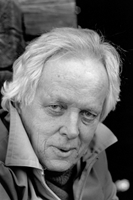1973 Veijo Meri, Finland: Kersantin poika

About the author
Veijo Meri was born in Viipuri, studied history at the University of Helsinki and made his debut with a collection of short stories in 1954. Veijo Meri is one of the leaders of Finnish modernism and boasts a considerable production of work. He has written in many genres but always been faithful to his own personal style. Academically, he has also been industrious, translating works such as Hamlet and Master Olof into Finnish. His own work has been translated into 24 languages.
About the winning piece
Kersantin poika takes place during the 1939 Winter War in Finland. The novel depicts the life in the barracks of the then Finnish town of Valkjärvi, situated in Karelia. The narrative style shows several typical characteristics of modernism. The language is certainly clear and concise, but the narrator is not omniscient, and the viewpoint changes with the people in the story, making the picture of reality and events fragmented and uncertain. The reader’s visual field does not exceed the limited perspective of the figures in the novel. This method underlines the picture of the chaotic absurdity of war where coincidence controls so many developments and people are left destitute and lonely.
Kersantin poika
Published by: Otava Publishing Company
Publication year: 1971
This is what the Adjudicating Committee had to say
”Kersantin poika” contains an artistically significant interpretation of a child’s experience of the world. At the same time the story reflects a threatening historical situation just before World War II. As in his earlier writings, Meri gives a detailed, humorous and sensual description of nature and people.